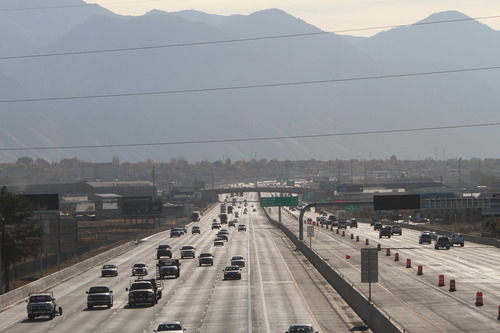This is an archived article that was published on sltrib.com in 2012, and information in the article may be outdated. It is provided only for personal research purposes and may not be reprinted.
Lindon • After nearly three years of massive construction, Utah highway officials announced Friday that the $1.1 billion rebuilding of Interstate 15 in Utah County is so near completion that all lanes will be opened permanently by the morning commute on Monday — earlier than originally expected.
That good news raised questions about whether its timing just before Election Day helps Gov. Gary Herbert. His administration has been attacked for a quiet $13 million payment to contractors who contended they were robbed of the 2009 bid by one point after state adjustments in bid scoring. The contract went instead to a consortium that had donated $82,500 to Herbert.
"It is very good timing, I must say. It is very interesting," Democrat Peter Cooke, who is challenging Herbert, said about the Friday announcement.
"I don't know enough about the project to know if this is unusual. But it does seem quite odd."
Asked if the Governor's Office had any involvement in the timing, project spokeswoman Leigh Dethman said the Utah Department of Transportation "chose to open the lanes as soon as they became available. It's been our goal all along to keep the traffic moving and open them when they are ready." She noted other sections have been opened earlier as work has been completed.
Herbert leads by a wide margin in most polls and the Governor's Office insisted it played no role in the timing.
"We had no involvement with the announcement," said spokeswoman Ally Isom. "We were notified just this week that the lanes would open Monday. Our understanding is that UDOT works out timing with the contractor, and when the lanes are ready, they are opened."
In August, Herbert toured the project and challenged contractors then to finish the project by Thanksgiving — earlier than the scheduled December completion — to help holiday traffic.
Also during that August tour, Herbert told reporters that the swift, efficient rebuild by Provo River Constructors proved the state awarded the contract to the correct firm in its controversial bid process.
He compared its quick work to the smaller $170 million reconstruction of State Road 92 from Lehi to Alpine, which finished 10 months behind schedule amid quality complaints and after $4.5 million in late fees were charged to the contractor, Flatiron/Harper Joint Venture.
Flatiron was part of a consortium that contended that state adjustment of bid scores robbed it of the I-15 contract.
UDOT paid $13 million to losing contractors to prevent lawsuits, and to gain rights to ideas in their proposals — some of which were incorporated into the project.
Audits later found no wrongdoing or political pressure by UDOT and Herbert over the bid, but a state auditor's report said auditors couldn't determine whether the bid process and settlement payment were fair because of a lack of documentation.
That audit also criticized UDOT for not concealing identities of the bidders, providing misleading information to one bidder about how proposals would be evaluated, and for including on the UDOT evaluation team someone married to an employee of one of the bidding contractors.
Cooke said Friday, "Integrity has to be preserved in the bidding process, and it was not" in this case.
Dethman, during a media availability Friday announcing the lane openings, said this "will be the fastest $1 billion [highway] project ever completed in the United States," and comes while most lanes were open most of the time during construction.
She said two new travel lanes will now be opened for 24 miles between Lehi and Spanish Fork.
"We still have work to do. We're planning on doing all that work at night, so we can keep traffic moving," Dethman said. She added that night work may involve some lane restrictions.
Most remaining work includes such things as landscaping, painting lane stripes, fencing, final inspections and work on express lane equipment.
"We are on schedule to finish the whole project in December," she said. Until then, she added, "express lanes are still being tested so those will be carpool-only," and not open to people who use transponders to pay toll in other sections.
Besides adding lanes, the project rebuilt 10 freeway interchanges and replaced or modified 63 bridges. Crews used 2.6 million square yards of concrete, which could pave a sidewalk from coast to coast. It used 7.7 million tons of dirt, which could fill Brigham Young University's Marriott Center 13 times. The project also installed 49 miles of drainage pipe, twice the length of Utah Lake.
Dethman said the project vhas entailed 6.6 million man-hours of work. In comparison, the Empire State Building required 7 million man-hours.







